| Author |
Message |
|
Jeremy V. Krause
|
 Posted: Fri 07 Sep, 2007 4:03 pm Post subject: Posted: Fri 07 Sep, 2007 4:03 pm Post subject: |
 |
|
That's an interesting photo that Chad posted above from the Melanese codex with the tall horns as the occulum (sp?) looks to be rather large. I am used to seeing historical examples of great helms with very thin occulum and very small breath holes. Usually the occulum extend out from the plane of the helm in a "v" shape that really shows the effort payed to the avoidance of unwanted "foreign matter." Yes, I'll call it foreign matter.
Jeremy
|
|
  |
 |
|
Gregory J. Liebau
Location: Dinuba, CA Joined: 27 Nov 2004
Posts: 669
|
 Posted: Fri 07 Sep, 2007 5:14 pm Post subject: Posted: Fri 07 Sep, 2007 5:14 pm Post subject: |
 |
|
Chad, I'd like to note that the Von Prankh helm dates from about 1350, while the Codex is most certainly from the very first years of the century. The changes in great helms over this period, much like all other forms of arms and armour, were drastic. I was able to see the Von Prankh helm in person while in Vienna, and will share a couple of images, if I may.
In any case, the reason I bring this up is that the Von Prankh helm, with it's extra face-guard and particular mid-14th century shape, would not be suitable for the purposes of the OP. Nor would the crest, which is likely to be even later than the construction date of the helm (if not by much) be similar to those seen in the 13th century.
-Gregory-


 Attachment: 77.57 KB Attachment: 77.57 KB
[ Download ]
 Attachment: 76.89 KB Attachment: 76.89 KB
[ Download ]
My Flickr Galleries - Travel, Nature & Things
|
|
  |
 |
|
Jeremy V. Krause
|
 Posted: Fri 07 Sep, 2007 6:10 pm Post subject: Posted: Fri 07 Sep, 2007 6:10 pm Post subject: |
 |
|
Hello Gregory,
I'm sorry but I can't tell by the pictures above if there are any breath holes in this helm. Could you let me know.
Jeremy
|
|
  |
 |
|
Gregory J. Liebau
Location: Dinuba, CA Joined: 27 Nov 2004
Posts: 669
|
 Posted: Fri 07 Sep, 2007 6:23 pm Post subject: Posted: Fri 07 Sep, 2007 6:23 pm Post subject: |
 |
|
Yes, there are. There is a reinforcing plate over the top of the helm that protects the wearer during the joust. This helm is obviously set up for tourney use, considering that and the fact that it has such an extravagant crest. In my opinion this is a perfect example of a German jousting helm from about 1350-1360.
I do not have any images of the helm with the plate detached from it, but I believe the breaths under it are simple circles in some rather plain order (probably a V) You'll note that the reinforcing plate does not extend around the entire helm, and only protects the whole front left side of the face.
-Gregory-
 Attachment: 12.17 KB Attachment: 12.17 KB

My Flickr Galleries - Travel, Nature & Things
|
|
  |
 |
Chad Arnow
myArmoury Team


|
 Posted: Fri 07 Sep, 2007 8:08 pm Post subject: Posted: Fri 07 Sep, 2007 8:08 pm Post subject: |
 |
|
| Gregory J. Liebau wrote: | Chad, I'd like to note that the Von Prankh helm dates from about 1350, while the Codex is most certainly from the very first years of the century. The changes in great helms over this period, much like all other forms of arms and armour, were drastic.
|
Indeed; that was my point. Helms like the von Prankh helm and crests like the Manesse Codex both post-date the main era of the Northern Crusades, by varying amounts of course. So neither a helm of the von Prankh form (which Ryan recommended) nor a horned crest like the von Prankh helm or the ones found in the Manesse Codex, would really fit the bill for what the original poster was looking for.
Thanks for those pics, Gregory. I love that helm. 

ChadA
http://chadarnow.com/
|
|
    |
 |
Chad Arnow
myArmoury Team


|
 Posted: Fri 07 Sep, 2007 8:10 pm Post subject: Posted: Fri 07 Sep, 2007 8:10 pm Post subject: |
 |
|
| Jeremy V. Krause wrote: | Yes, I see your point,
I went back and looked at Albion's site after I posted and noticed that Peter does attribute this type of sword to the early 13th c. Personally, I feel more strongly that this sword should not be dated earlier than 1200. It does not have the spirit of the 12th c. in my mind.
I think it could be reasonable to have a sword dated 1225-1250 and a helm dated 1300. Date the helm 1350 and I think we would be stretching it. Give the sword a slightly latter period scabbard and I think it would be cool.
|
I think the Ritter is a great sword for an earlier Teutonic knight kit, but I'd love to see it paired with a proto-great helm. That would be fantastic. We don't see enough of those transitional great helms in the market.

ChadA
http://chadarnow.com/
|
|
    |
 |
Ryan Renfro

|
 Posted: Sat 08 Sep, 2007 3:37 am Post subject: Posted: Sat 08 Sep, 2007 3:37 am Post subject: |
 |
|
Chad, Iíd certainly concede that pushing the Ritter out to 1350 would be stretching it. I guess I would just be more willing to go with cultural/regional factors and aesthetic preferences for particular pieces rather than a strict adherence to dating in this instance if we are talking about a helm of about 1300.
If Steven is looking at a time span stretching from roughly the Golden Bull of Rimini in 1226 to Tannenberg in 1410, then heís got a fair number of options open to him. Sounds like he may want to establish a helm from this period first, then base his choice of blades upon that.
Gregory, do you have any idea of what materials have been used to construct the crest on the Von Prankh?
|
|
  |
 |
Chad Arnow
myArmoury Team


|
 Posted: Sat 08 Sep, 2007 7:31 am Post subject: Posted: Sat 08 Sep, 2007 7:31 am Post subject: |
 |
|
| Ryan Renfro wrote: | | Gregory, do you have any idea of what materials have been used to construct the crest on the Von Prankh? |
Not Gregory, but a book I have says the horns are made of moulded silver and gilded leather mounted on a leather cap.

ChadA
http://chadarnow.com/
|
|
    |
 |
|
Jeremiah Swanger
|
 Posted: Sat 08 Sep, 2007 11:34 am Post subject: Posted: Sat 08 Sep, 2007 11:34 am Post subject: |
 |
|
| Chad Arnow wrote: |
The museum the Ritter's inspiration lives in dates it to the early 13th century. I'd hope their curators did that for a reason.  Also, the maker of the repro (Albion) dates it to the first half of the 13th century. Oakeshott considered the blade type to be most common to the period 1100-1175 or thereabouts. Taken together, a convincing case can be made for the sword being most typical to the 12th or early 13th century. Could it date to 1250? Sure, but people a lot more learned than me seem to think it belongs earlier in the century. Also, the maker of the repro (Albion) dates it to the first half of the 13th century. Oakeshott considered the blade type to be most common to the period 1100-1175 or thereabouts. Taken together, a convincing case can be made for the sword being most typical to the 12th or early 13th century. Could it date to 1250? Sure, but people a lot more learned than me seem to think it belongs earlier in the century.
|
Hi Chad,
I feel I have to differ with you a bit. You are working under the assumption that the Ritter is a Type XI sword. In my opinion, it doesn't look, or handle like, an XI at all. The balance point is too close to the hilt, the profile doesn't fit, and the fuller is a bit too short. Having handled the Ritter, I would say it feels like a longer, slimmer Tritonia, which was a clear XIIIb. If anything, I consider the Ritter to be a long-fullered, slightly-tapered XIIIb, if anything, though Albion admits that the Ritter's blade doesn't exactly fit neatly into the Oakeshott typology.
If viewed in this light, it may be accurate to say that the Ritter, though its inspiration dated back to the early 13th century, would easily fill the same gap as any XIIIb, which were in use as late as the mid-14th century. Thus, in my opinion, it would be accurate to say that the Ritter would be a very appropriate sword for a late-13th century Teutonic kit.
"Rhaegar fought nobly.
Rhaegar fought valiantly.
Rhaegar fought honorably.
And Rhaegar died."
- G.R.R. Martin's A Song of Ice and Fire
|
|
   |
 |
Chad Arnow
myArmoury Team


|
 Posted: Sat 08 Sep, 2007 12:47 pm Post subject: Posted: Sat 08 Sep, 2007 12:47 pm Post subject: |
 |
|
| Jeremiah Swanger wrote: |
Hi Chad,
I feel I have to differ with you a bit. You are working under the assumption that the Ritter is a Type XI sword. In my opinion, it doesn't look, or handle like, an XI at all. The balance point is too close to the hilt, the profile doesn't fit, and the fuller is a bit too short. Having handled the Ritter, I would say it feels like a longer, slimmer Tritonia, which was a clear XIIIb. If anything, I consider the Ritter to be a long-fullered, slightly-tapered XIIIb, if anything, though Albion admits that the Ritter's blade doesn't exactly fit neatly into the Oakeshott typology.
If viewed in this light, it may be accurate to say that the Ritter, though its inspiration dated back to the early 13th century, would easily fill the same gap as any XIIIb, which were in use as late as the mid-14th century. Thus, in my opinion, it would be accurate to say that the Ritter would be a very appropriate sword for a late-13th century Teutonic kit. |
We do differ.  There's more than the blade form that dates the Ritter and its inspiration to earlier in the 13th century in my mind. The blade is but one element. And balance point alone doesn't determine blade typology. Saying a sword handles more or less like a certain type or doesn't handle like another is dangerous and unprovable ground upon which to tread. Have you handled enough representative samples of each type to be able to state that with certainty? What is a representative example of each of those types anyway? Do you see my point? There's more than the blade form that dates the Ritter and its inspiration to earlier in the 13th century in my mind. The blade is but one element. And balance point alone doesn't determine blade typology. Saying a sword handles more or less like a certain type or doesn't handle like another is dangerous and unprovable ground upon which to tread. Have you handled enough representative samples of each type to be able to state that with certainty? What is a representative example of each of those types anyway? Do you see my point? 
While the pommel form the original sword sports can date up to 1275, and the blade form might date that late or later (if you interpret it one way or other), and even though swords could see long life spans, I agree with curators and scholars that have dated that particular sword to earlier in the century.
For swords with similar blades and pommels, I think they're most typical of 1200-1250 or so. This doesn't mean that they weren't made and/or used earlier or later, but based on what I've studied I feel they are most appropriate for 1200-1250. Opinions will vary and that's fine; I've simply been stating my opinion all along, not trying to sell it as fact.
Also, I find it entertaining that people want to debate me about the date Albion assigned to the Ritter and that the Deutsches Historisches Museum assigned to the sword Albion based it on, as well as the dates Oakeshott assigned to his typology.  I guess it's because I happen to agree with the dating. I guess it's because I happen to agree with the dating.
We don't have to agree on this and some of it is subjective. I think it's important to give Steven good info on possible dates for this sword. It's possible no one will be ever able to prove that this sword is of one date or other, so if Steven thinks it works for what he wants, that's fine. My own personal opinion about what part of the century it fits in is no more or less relevant than anyone else's, is it? 

ChadA
http://chadarnow.com/
|
|
    |
 |
|
Gregory J. Liebau
Location: Dinuba, CA Joined: 27 Nov 2004
Posts: 669
|
 Posted: Sat 08 Sep, 2007 2:27 pm Post subject: Posted: Sat 08 Sep, 2007 2:27 pm Post subject: |
 |
|
| Chad Arnow wrote: | | Not Gregory, but a book I have says the horns are made of moulded silver and gilded leather mounted on a leather cap. |
That sounds right based on the description I've been given. I would be able to confirm it but my book from the museum that includes a page on the helm is written in German, and I'm certainly not handy enough with the language (yet!) to translate it nor even find where it talks about the crest!
-Gregory-
My Flickr Galleries - Travel, Nature & Things
|
|
  |
 |
Ryan Renfro

|
 Posted: Sun 09 Sep, 2007 6:11 am Post subject: Posted: Sun 09 Sep, 2007 6:11 am Post subject: |
 |
|
Steven,
Iíve been looking around at some of the German sites and found a couple that had a few decent great helms at reasonable prices, but nothing fitting your exact specifications as far as horns go:
https://www.shop.selten-handwerk.de/index.php?rubrik=48
http://die-ritterschmiede.com/Ritterhelm_Ritt...chauk.html
Then I noticed this tournament helm over at medievalrepro.com and concluded there was no sense in searching any further. At least the 12-month waiting list gives one some time to save up the 1,200+ CAD for one of their great helms!
 Attachment: 15.41 KB Attachment: 15.41 KB
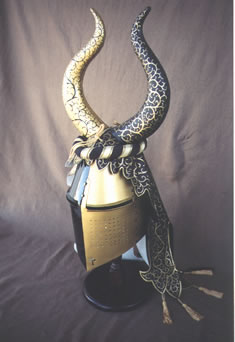
|
|
  |
 |
Randall Moffett

|
 Posted: Sun 09 Sep, 2007 6:22 am Post subject: Posted: Sun 09 Sep, 2007 6:22 am Post subject: |
 |
|
I'd get a great helm like this one from Wells Cathedral, 1230-40 personally. A very nice early full great helm to go with your plans.
RPM
 Attachment: 74.44 KB Attachment: 74.44 KB
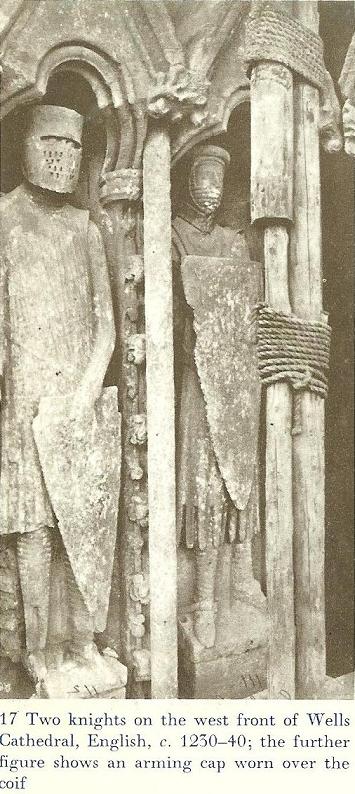
|
|
  |
 |
Chad Arnow
myArmoury Team


|
 Posted: Sun 09 Sep, 2007 6:34 am Post subject: Posted: Sun 09 Sep, 2007 6:34 am Post subject: |
 |
|
| Ryan Renfro wrote: | | Then I noticed this tournament helm over at medievalrepro.com and concluded there was no sense in searching any further. At least the 12-month waiting list gives one some time to save up the 1,200+ CAD for one of their great helms! |
Steven,
That's one of my favorite great helm reproductions. It's a great mid-to-late 14th century helm/crest combo. Here's the description from that website:
| Quote: | Great Helm with Tournament Crest c. 1375
We did this helm on a whim, and were very pleased with the way it turned out. The crest is based on one in the Churburg Collection, made of bass-wood and covered with leather. The leather mantle is copied from a 14th century manuscript illustrating tournament helms from the period.
|

ChadA
http://chadarnow.com/
|
|
    |
 |
|
Jeremiah Swanger
|
 Posted: Sun 09 Sep, 2007 10:27 pm Post subject: Posted: Sun 09 Sep, 2007 10:27 pm Post subject: |
 |
|
| Chad Arnow wrote: |
We do differ.  There's more than the blade form that dates the Ritter and its inspiration to earlier in the 13th century in my mind. The blade is but one element. And balance point alone doesn't determine blade typology. Saying a sword handles more or less like a certain type or doesn't handle like another is dangerous and unprovable ground upon which to tread. Have you handled enough representative samples of each type to be able to state that with certainty? What is a representative example of each of those types anyway? Do you see my point? There's more than the blade form that dates the Ritter and its inspiration to earlier in the 13th century in my mind. The blade is but one element. And balance point alone doesn't determine blade typology. Saying a sword handles more or less like a certain type or doesn't handle like another is dangerous and unprovable ground upon which to tread. Have you handled enough representative samples of each type to be able to state that with certainty? What is a representative example of each of those types anyway? Do you see my point? 
While the pommel form the original sword sports can date up to 1275, and the blade form might date that late or later (if you interpret it one way or other), and even though swords could see long life spans, I agree with curators and scholars that have dated that particular sword to earlier in the century.
For swords with similar blades and pommels, I think they're most typical of 1200-1250 or so. This doesn't mean that they weren't made and/or used earlier or later, but based on what I've studied I feel they are most appropriate for 1200-1250. Opinions will vary and that's fine; I've simply been stating my opinion all along, not trying to sell it as fact.
Also, I find it entertaining that people want to debate me about the date Albion assigned to the Ritter and that the Deutsches Historisches Museum assigned to the sword Albion based it on, as well as the dates Oakeshott assigned to his typology.  I guess it's because I happen to agree with the dating. I guess it's because I happen to agree with the dating.
We don't have to agree on this and some of it is subjective. I think it's important to give Steven good info on possible dates for this sword. It's possible no one will be ever able to prove that this sword is of one date or other, so if Steven thinks it works for what he wants, that's fine. My own personal opinion about what part of the century it fits in is no more or less relevant than anyone else's, is it?  |
Hi Chad,
I'd just like to point out that I never once called the date of the original sword into question. I'm quite certain that the teams of archaeologists, museum staff, various other scholars of history, Dr. Oakeshott himself, Albion's R&D team, and carbon dating are capable of producing a fairly accurate date.
The question asked was "would this be appropriate?" With a pommel that remained in fashion until 1275, and a blade style that, in my own, admittedly-limited experience, is perfectly capable of matching an established type that saw its peak usage from the mid-1200's to the mid-1300's, I think an answer of "yes, but that hilt is sooo 5 minutes ago!" might be fairly accurate! 
Perhaps we can use this debate as reason for Albion to make something called "The Teuton!" 
Either way, since a Teutonic Knight kit is in my long-term plans as well, I would like to know if something like A&A's "Pembridge" helm would be appropriate, even though the original was dated to the Hundred Years war. There appears to be numerous similarities in shape and form to the examples posted earlier in this thread. Even though they are examples of excellent craftsmanship, I see myself going for something a little less gaudy...
"Rhaegar fought nobly.
Rhaegar fought valiantly.
Rhaegar fought honorably.
And Rhaegar died."
- G.R.R. Martin's A Song of Ice and Fire
|
|
   |
 |
Randall Moffett

|
 Posted: Sun 09 Sep, 2007 11:05 pm Post subject: Posted: Sun 09 Sep, 2007 11:05 pm Post subject: |
 |
|
I would say the pembridge would be out of the time frame. The helmets of the late great helm type get massive in size. A Great article came out from the Royal Armouries Journal a year back on great helms. If you can get a copy, I believe it is for sale online for not much, it would be very helpful to see the great helm development then chose one that fits the time you wish.
RPM
|
|
  |
 |
Troy G L Williams

|
 Posted: Sun 09 Sep, 2007 11:45 pm Post subject: Posted: Sun 09 Sep, 2007 11:45 pm Post subject: |
 |
|
Would it be reasonable to say that one of these helmets from Steel Mastery http://www.steel-mastery.com/index.php?&m...rent_id=17 might fit the appropriate time period? The do state that they are 13th Century but that doesn't always mean that they are. Most of the time it is interpretation. 
 Attachment: 25.22 KB Attachment: 25.22 KB
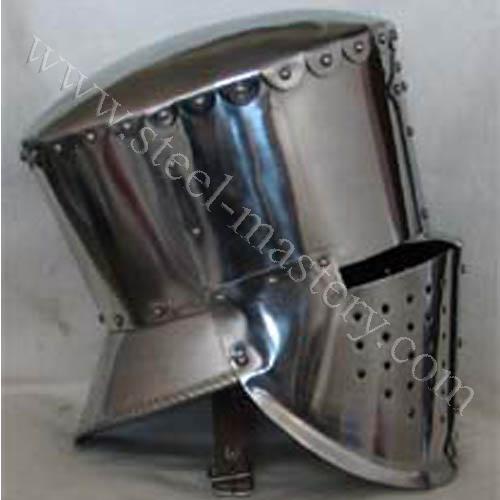
 Attachment: 23.19 KB Attachment: 23.19 KB
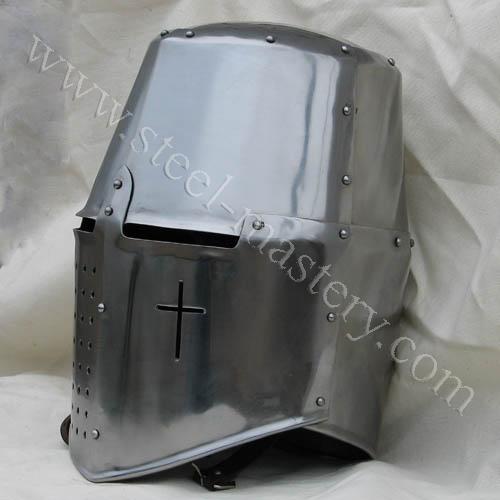
v/r,
Troy Williams
"Itís merely a flesh wound." -Monty Python and the Holy Grail
|
|
  |
 |
Troy G L Williams

|
 Posted: Mon 10 Sep, 2007 12:04 am Post subject: Posted: Mon 10 Sep, 2007 12:04 am Post subject: |
 |
|
| Chad Arnow wrote: |
That helm doesn't appear very historic. It does have horns, but the surviving historical horned crests we have are not made of entirely of steel and rivetted to the side of the helm. I can't recall any historical manuscripts that show a helm with horns like that either.
People keep recommending the Ritter, which is a fine sword for a Teutonic kit (and a fine sword in general).  However, the helms posted fall pretty clearly into the latter half of the 13th century, while the Ritter belongs pretty clearly to the early part of the 13th century. However, the helms posted fall pretty clearly into the latter half of the 13th century, while the Ritter belongs pretty clearly to the early part of the 13th century.
This is a helm from the Maciejowski Bible, which is from circa 1250. Even it is approaching being too late for the Ritter, and it's not even a fully developed great helm:
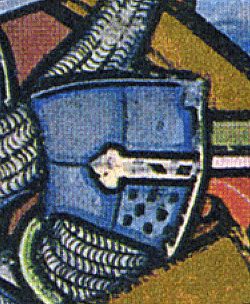 |
I remembered that Outfit4Events http://www.outfit4events.com/helmets-pot-helmet-c-26_29_178.html had a helm similar to the one Chad presented an image of above. It looks pretty close.  They have other styles as well of earlier helms as well. They have other styles as well of earlier helms as well.
 Attachment: 40.77 KB Attachment: 40.77 KB
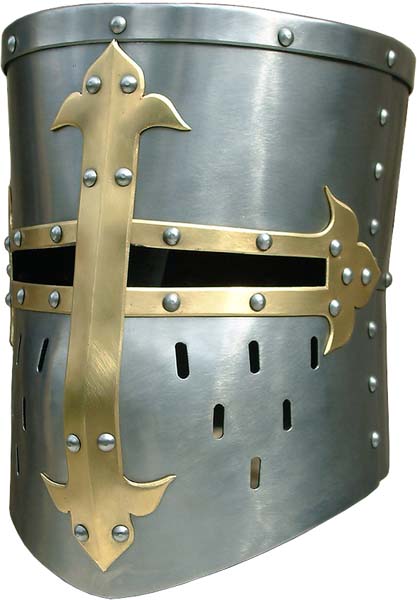
v/r,
Troy Williams
"Itís merely a flesh wound." -Monty Python and the Holy Grail
|
|
  |
 |
Randall Moffett

|
 Posted: Mon 10 Sep, 2007 1:57 am Post subject: Posted: Mon 10 Sep, 2007 1:57 am Post subject: |
 |
|
Troy,
They are 13th century great helms. The first is around the second decade to the 6th or 7th and the second is later likely after 1250 or 1260. I think the main characteristics are earlier the back is not usually as long. The Wells one is though so this is a general rule. Most seem to be very short as the first you posted. Second the top starts becoming tapered as time goes on. The vision slot tends to be without nasal more often than not in the 1st half anfd into the beginning of the second half of the 13th.
RPM
|
|
  |
 |
|
William P
|
 Posted: Tue 09 Aug, 2011 11:18 pm Post subject: Posted: Tue 09 Aug, 2011 11:18 pm Post subject: |
 |
|
this is what wikipedia suggests might be the cause of the horned viking helmet phenomena
| Quote: | Ceremonial use of horned helmets during the Germanic Iron Age persisted until the 7th century and can thus be argued to may have overlapped with the early Viking Age. But there is no evidence that horned helmets were ever worn in battle throughout the Viking Age.
Nevertheless, popular culture came to associate horned helmets strongly with Viking warriors. The popular association probably arose in 19th century Swedish Romanticism, possibly by misattribution of Bronze Age images such as the Grevensvśnge figurines. |
theres also helms like the waterloo helm
http://en.wikipedia.org/wiki/Waterloo_Helmet
 Attachment: 61.64 KB Attachment: 61.64 KB
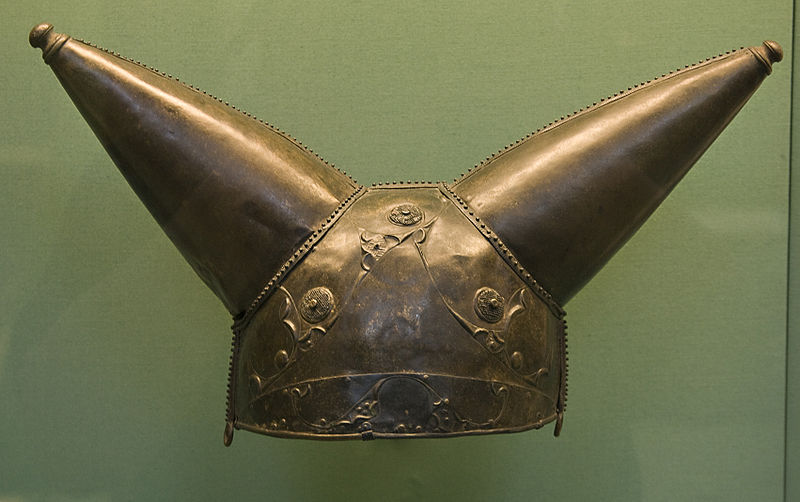
the waterloo helmet
|
|
   |
 |
|
|
You cannot post new topics in this forum
You cannot reply to topics in this forum
You cannot edit your posts in this forum
You cannot delete your posts in this forum
You cannot vote in polls in this forum
You cannot attach files in this forum
You can download files in this forum
|
All contents © Copyright 2003-2024 myArmoury.com — All rights reserved
Discussion forums powered by phpBB © The phpBB Group
Switch to the Basic Low-bandwidth Version of the forum
|

